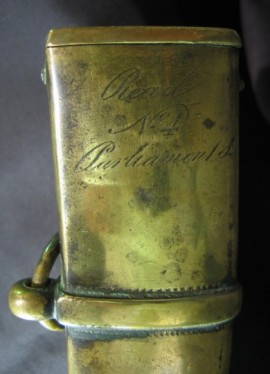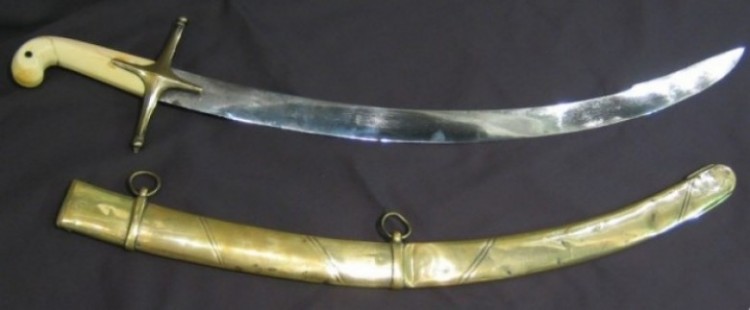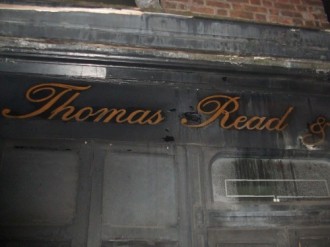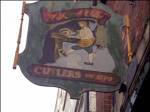Thomas Read of Dublin
AN IRISH GEORGIAN NAVAL SWORD, BY THOMAS READ, DUBLIN.
Mameluke Naval Hanger, c. 1800, Diamond shaped brass cross guard with ball finials on quillions, Ivory grip, a 24 inch curved blade with a 6 inch false spear point return, brass scabbard with two ring mounts and engraved “Read / No. 4 / Parliament S.”

Occasionally, an item appears that is not what it seems or, at least, not what we assume it to be at first glance. When this hanger appeared in the gallery, I read the engraved maker’s name on the top mount of the scabbard and automatically assumed it to be a London made weapon. After all, it said “Parliament S.”. It was only when I began to research the maker that I discovered that I had a piece that was a bit of a rarity, namely a Dublin made Georgian naval sword. (I believe this to be naval, despite having a full brass scabbard, owing to its length.) Moreover, the maker and his shop had a story all their own.
Thomas Read originally established himself independently in premises at 4 Parliament Street, Dublin, Ireland, some years before the city directory of 1782. Later he traded as Read & Co. from 1808 onwards. (He is not to be confused with John Read, also a sword cutler during the same period, who had premises at 8 College Green.) Thomas Read became a member of the Irish Cutlers Guild of St. Luke in 1749. When his father died, Read took over the family business in 1776, and as a Master Cutler would have been at his prime between 1776 and 1808. Amazingly, especially for those who value furniture of the Georgian period, Thomas Chippendale supplied the display cabinets of the shop (which, apparently, remain in situ to the present time)
This naval hanger was likely manufactured between 1799 and 1805. This can be easily surmised as Mameluke style swords only came into fashion following Napoleon’s invasion of Egypt and the subsequent Battle of the Nile (1-3 August 1798). In 1805, however, a regulation naval officer’s sword, with no resemblance to the Mameluke style, was introduced into the Royal Navy. Additionally, as noted above, Read’s trade name changed shortly afterwards in 1808.

Thomas Read’s shop front at 4 Parliament Street, Dublin, is still extant, although the business is now closed. As the Irish Times noted in 1997:
Read's of Parliament Street, the oldest shop in Dublin, has closed "until further notice" and is unlikely ever to reopen as a cutlers. The business was founded in 1675 and had been trading at its present location for over 200 years.
Through peaceful and turbulent times over the past two centuries it was the place to buy a good pair of scissors or a set of kitchen knives. All of its current stock, housed in glass cabinets, is still in place behind the shuttered windows. Mr. Michael Smith, of An Taisce, said Read's was another victim of the property boom, along with many other Dublin icons which had become casualties of the Celtic Tiger economy that was turning the city into a "faceless, nameless place".
"An Taisce has been railing about this for years, that loads of money plus inadequate protection for our heritage spells cultural collapse at a rate that's directly proportionate to our economic growth. Other cities are more careful to retain the things that are important."
Mr. Smith said Read's was not only the oldest but also the most charming shop in Dublin, with much of its interior still intact. "The owner promised to keep it and even to put in a museum on the first floor, but, needless to say, this hasn't happened," he added.

Mr. Hugh O'Regan, the pub transformation wizard who acquired Read's four years ago, told The Irish Times that it was "unlikely we will reopen it as a cutlers' shop", though he emphasized that no final decision had been taken on its fate.
"We had a couple of bad incidents there recently. Ronnie Carbury, the cutler who had served in the shop for 40 years, was threatened by three guys with knives who robbed the till. There wasn't much in it, admittedly, as the shop doesn't make any money."
Mr. O'Regan borrowed the name of its founder, Thomas Read, for his pub next door, which incorporates The Oak bar on Dame Street. Its interior contains elements of the elaborately carved pulpit from St George's Church in Hardwicke Place.
He has planning permission for a hotel on the upper floors of Thomas Read's and The Oak, having initially considered an apartment conversion. Two apartments and the promised museum were to be installed on the upper floors of the old cutlers' shop.

"It would be great to maintain the shop as a cutlers, but unfortunately it doesn't pay. If someone came up with a range of goods that would appeal to tourists, I would consider it," Mr. O'Regan said. "On the other hand, maybe the OPW would like to take it over."
Mr. O’Regan and his Public House holdings went into receivership and liquidation in 2009 and, at the time of writing (August 2011) the building at No. 4 Parliament Street remains shuttered and derelict.
As a sword maker, Read catered to the Anglo-Irish aristocracy. A number of swords bearing his name may be found in the arms and armor collection of the National Museum of Ireland housed in the former Collin’s Barracks (formerly the Royal Barracks and named for Michael Collins in 1922, following the surrender of the buildings to the Irish Free State). Another example of a Read Naval Sword of the period may be found in the superlative study by Sim Comfort, Naval Swords and Dirks, Vol. I, p. 176 (EW 93). Read, interestingly, is also famous among corkscrew collectors for the prized “Read’s Coaxer”, among the most sought after of finds in the hobby.